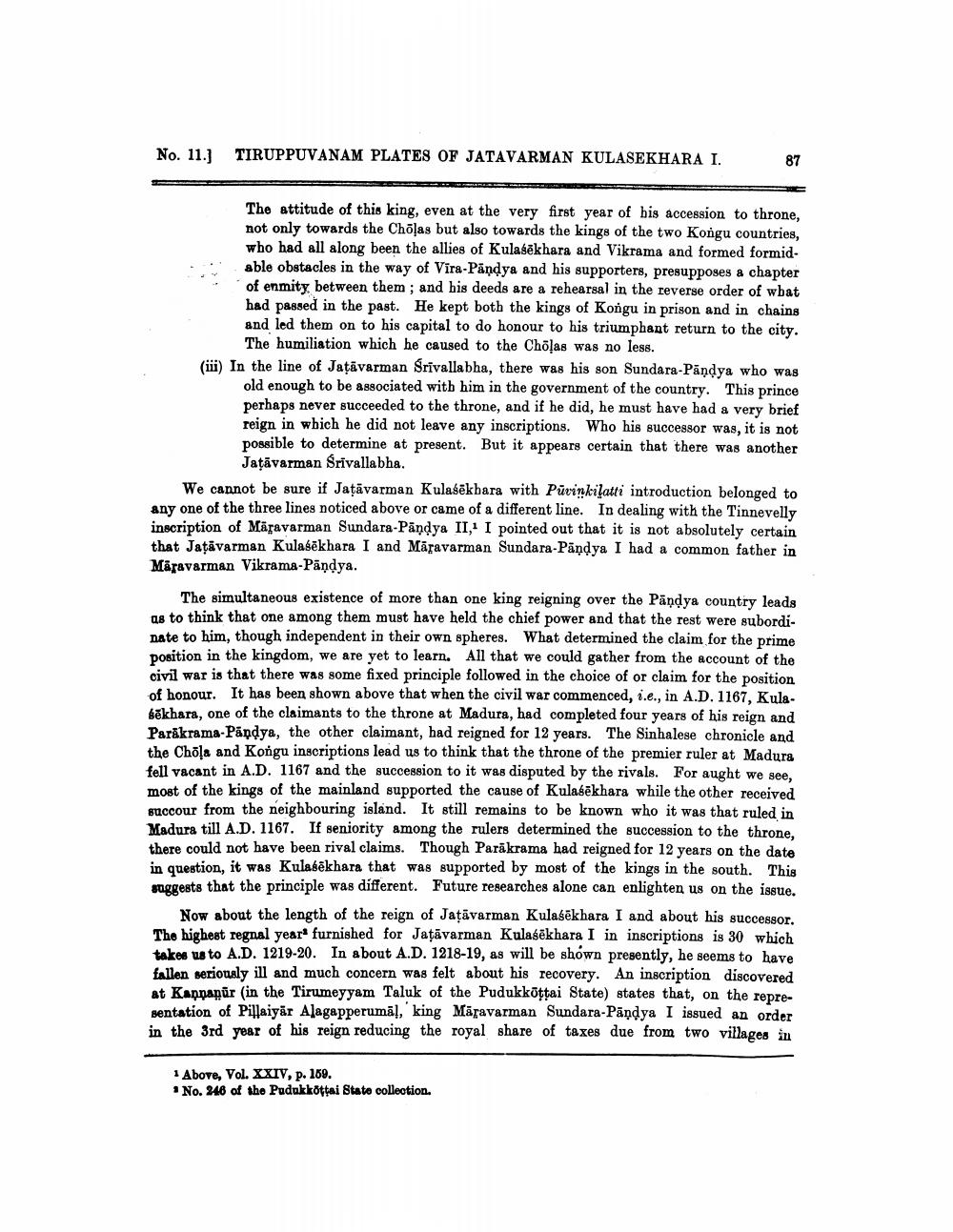________________
No. 11.) TIRUPPUVANAM PLATES OF JATAVARMAN KULASEKHARA I.
The attitude of this king, even at the very first year of bis accession to throne, not only towards the Chõļas but also towards the kings of the two Kongu countries, who had all along been the allies of Kulasēkhara and Vikrama and formed formidable obstacles in the way of Vira-Pāndya and his supporters, presupposes a chapter of enmity between them; and his deeds are a rehearsal in the reverse order of wbat had passed in the past. He kept both the kings of Kongu in prison and in chains and led them on to his capital to do honour to his triumphant return to the city.
The humiliation which he caused to the Cholas was no less. (iii) In the line of Jaţävarman Srivallabha, there was his son Sundara-Pandya who was
old enough to be associated with him in the government of the country. This prince perhaps never succeeded to the throne, and if he did, he must have had a very brief reign in which he did not leave any inscriptions. Who his successor was, it is not possible to determine at present. But it appears certain that there was another
Jaţāvarman Srivallabha. We cannot be sure if Jatävarman Kulasēkbara with Püvinkilatti introduction belonged to any one of the three lines noticed above or came of a different line. In dealing with the Tinnevelly inscription of Māravarman Sundara-Pāndya II, I pointed out that it is not absolutely certain that Jatavarman Kulasēkhara I and Māravarman Sundara-Pandya I had a common father in Märavarman Vikrama-Pandya.
The simultaneous existence of more than one king reigning over the Pāņdya country leads as to think that one among them must have held the chief power and that the rest were subordinate to him, though independent in their own spheres. What determined the claim for the prime position in the kingdom, we are yet to learn. All that we could gather from the account of the civil war is that there was some fixed principle followed in the choice of or claim for the position of honour. It has been shown above that when the civil war commenced, i.e., in A.D. 1167, Kulabēkhara, one of the claimants to the throne at Madura, had completed four years of his reign and Parákrama-Pandya, the other claimant, had reigned for 12 years. The Sinhalese chronicle and the Chola and Kongu inscriptions lead us to think that the throne of the premier ruler at Madura fell vacant in A.D. 1167 and the succession to it was disputed by the rivals. For aught we see, most of the kings of the mainland supported the cause of Kulasēkhara while the other received succour from the neighbouring island. It still remains to be known who it was that ruled in Madura till A.D. 1167. If seniority among the rulers determined the succession to the throne, there could not have been rival claims. Though Parākrama had reigned for 12 years on the date in question, it was Kulasēkhara that was supported by most of the kings in the south. This suggests that the principle was different. Future researches alone can enlighten us on the issue.
Now about the length of the reign of Jațăvarman Kulasēkhara I and about his successor. The highest regnal year. furnished for Jaţāvarman Kulasekhara I in inscriptions is 30 which takes us to A.D. 1219-20. In about A.D. 1218-19, as will be shown presently, he seems to have fallen seriously ill and much concern was felt about his recovery. An inscription discovered at Kannanûr (in the Tirumeyyam Taluk of the Pudukkottai State) states that, on the representation of Pillaiyar Alagapperumal, king Māravarman Sundara-Pāndya I issued an order in the 3rd year of his reign reducing the royal share of taxes due from two villages in
1 Above, Vol. XXIV, p. 169. * No. 248 of the Pudukkottai Stato collection




